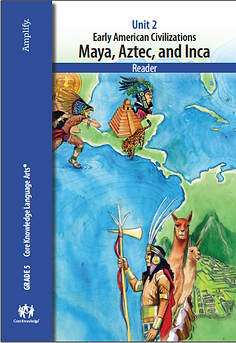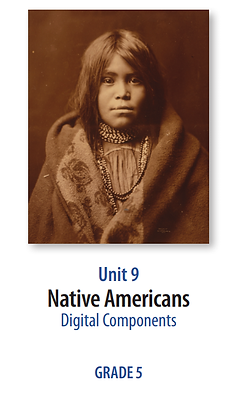Grade 5
Unit 2: Early American Civilizations
Focus: Students develop reading, writing, listening, and thinking skills through engagement with informational text in the Student Reader Maya, Aztec, and Inca. Students explore the complex civilizations developed by the Maya, Aztec, and Inca prior to the arrival of Europeans. Students learn about the geography of each region. They learn about the innovations and discoveries made in these civilizations, and read some of their myths. Students use the writing process to write an informative or explanatory report that compares and contrasts the three civilizations. Lessons include explicit instruction in grammar, morphology, and spelling.
Number of Lessons: 15
Lesson Time: 90 minutes each. Each lesson may be divided into shorter segments.
Additional Search Terms: ancient civilizations • Native Americans • fragments and run-on sentences • action and linking verbs
Unit 6: The Renaissance
Focus: Students develop reading, writing, listening, and thinking skills through engagement with informational text in the Student Reader Patrons, Artists, and Scholars. Students explore the Renaissance, the “rebirth” of ideas from ancient Greece and Rome that began in powerful Italian city states and then spread through much of Europe. Students learn how increased trade led to new wealth, and how wealthy families and the Church acted as patrons to support artists. Students are introduced to Renaissance art and literature through the works of masters such as Leonardo da Vinci, Michelangelo, Raphael, Donatello, Brunelleschi, Botticelli, Bruegel, Dürer, Van Eyck, Machiavelli, Castiglione, Cervantes, and Shakespeare. Students conduct research about a famous Renaissance artist to compose a biographical essay. Lessons include explicit instruction in grammar, morphology, and spelling.
Number of Lessons: 19
Lesson Time: 90 minutes each. Each lesson may be divided into shorter segments.
Additional Search Terms: Ancient Greece and Rome • sculpture • painting • perspective • Don Quixote • biography • linking verbs • prepositional phrases • correlative conjunctions
Unit 7: The Reformation
Focus: Students develop reading, writing, listening, and thinking skills through engagement with informational text in the Student Reader Shifts in Power. Students explore the Reformation, the 16th-century religious and political upheaval that challenged the power of the Catholic Church and led to the creation of Protestantism. Students learn about Gutenberg’s invention of an efficient printing press, which led to increased literacy while also fueling the Reformation by spreading the ideas of Martin Luther and others. Students learn how the scientific discoveries of Copernicus and Galileo challenged religious doctrine, and how the Church responded. Students write a friendly letter, and they plan and create a slide presentation. Lessons include explicit instruction in grammar, morphology, and spelling.
Number of Lessons: 10
Lesson Time: 90 minutes each. Each lesson may be divided into shorter segments.
Additional Search Terms: Calvin • Erasmus • Ignatius of Loyola and the Jesuits • interjections • subject-verb agreement
Unit 9: Native Americans
Focus: Students develop reading, writing, listening, and thinking skills through engagement with informational text in the Student Reader A Changing Landscape. Students learn about the Great Basin, Plateau, Plains, and Pacific Northwest Indians. Students explore the intricate connections between the ways of life of these Native American peoples and their specific regions and landscapes. Students learn how American government policies affected Native American cultures from the 1800s on. Students also read Native American myths and tales from specific peoples. In writing a persuasive essay, students practice skills of note-taking, incorporating evidence, and crafting an argument. Lessons include explicit instruction in grammar, morphology, and spelling.
Number of Lessons: 15
Lesson Time: 90 minutes each. Each lesson may be divided into shorter segments.
Additional Search Terms: Carlisle School • Westward Expansion • Battle of the Little Bighorn • Wounded Knee • Navajo Code Talkers





















